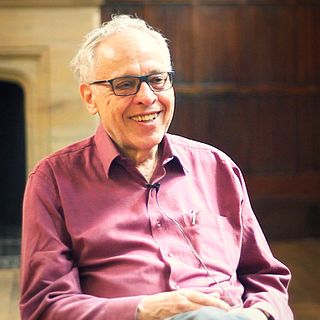Related Research Articles
The Astrophysical Journal (ApJ) is a peer-reviewed scientific journal of astrophysics and astronomy, established in 1895 by American astronomers George Ellery Hale and James Edward Keeler. The journal discontinued its print edition and became an electronic-only journal in 2015.

The American Astronomical Society is an American society of professional astronomers and other interested individuals, headquartered in Washington, DC. The primary objective of the AAS is to promote the advancement of astronomy and closely related branches of science, while the secondary purpose includes enhancing astronomy education and providing a political voice for its members through lobbying and grassroots activities. Its current mission is to enhance and share humanity's scientific understanding of the universe as a diverse and inclusive astronomical community.

Rainer "Rai" Weiss is an American physicist, known for his contributions in gravitational physics and astrophysics. He is a professor of physics emeritus at MIT and an adjunct professor at LSU. He is best known for inventing the laser interferometric technique which is the basic operation of LIGO. He was Chair of the COBE Science Working Group.

The Royal Astronomical Society (RAS) is a learned society and charity that encourages and promotes the study of astronomy, solar-system science, geophysics and closely related branches of science. Its headquarters are in Burlington House, on Piccadilly in London. The society has over 4,000 members ("Fellows"), most of them professional researchers or postgraduate students. Around a quarter of Fellows live outside the UK.

Michel Gustave Édouard Mayor is a Swiss astrophysicist and professor emeritus at the University of Geneva's Department of Astronomy. He formally retired in 2007, but remains active as a researcher at the Observatory of Geneva. He is co-laureate of the 2019 Nobel Prize in Physics along with Jim Peebles and Didier Queloz, and the winner of the 2010 Viktor Ambartsumian International Prize and the 2015 Kyoto Prize.

The Astronomical Society of the Pacific (ASP) is an American scientific and educational organization, founded in San Francisco on February 7, 1889, immediately following the solar eclipse of January 1, 1889. Its name derives from its origins on the Pacific Coast, but today it has members all over the country and the world. It has the legal status of a nonprofit organization.

Astronomy Picture of the Day (APOD) is a website provided by NASA and Michigan Technological University (MTU). According to the website, "Each day a different image or photograph of our universe is featured, along with a brief explanation written by a professional astronomer." The photograph does not necessarily correspond to a celestial event on the exact day that it is displayed, and images are sometimes repeated. However, the pictures and descriptions often relate to current events in astronomy and space exploration. The text has several hyperlinks to more pictures and websites for more information. The images are either visible spectrum photographs, images taken at non-visible wavelengths and displayed in false color, video footage, animations, artist's conceptions, or micrographs that relate to space or cosmology. Past images are stored in the APOD Archive, with the first image appearing on June 16, 1995. This initiative has received support from NASA, the National Science Foundation, and MTU. The images are sometimes authored by people or organizations outside NASA, and therefore APOD images are often copyrighted, unlike many other NASA image galleries.

Eugene Newman Parker was an American solar and plasma physicist. In the 1950s he proposed the existence of the solar wind and that the magnetic field in the outer Solar System would be in the shape of a Parker spiral, predictions that were later confirmed by spacecraft measurements. In 1987, Parker proposed the existence of nanoflares, a leading candidate to explain the coronal heating problem.
The Jackson-Gwilt Medal is an award that has been issued by the Royal Astronomical Society (RAS) since 1897. The original criteria were for the invention, improvement, or development of astronomical instrumentation or techniques; for achievement in observational astronomy; or for achievement in research into the history of astronomy. In 2017, the history of astronomy category was removed for subsequent awards and was transferred to a new award, the Agnes Mary Clerke Medal.

James Edward Gunn is the Eugene Higgins Professor of Astronomy at Princeton University. Gunn's early theoretical work in astronomy has helped establish the current understanding of how galaxies form, and the properties of the space between galaxies. He also suggested important observational tests to confirm the presence of dark matter in galaxies, and predicted the existence of a Gunn–Peterson trough in the spectra of distant quasars.

Joseph Ivor Silk FRS is a British-American astrophysicist. He was the Savilian Chair of Astronomy at the University of Oxford from 1999 to September 2011.

Marseille Observatory is an astronomical observatory located in Marseille, France, with a history that goes back to the early 18th century. In its 1877 incarnation, it was the discovery site of a group of galaxies known as Stephan's Quintet, discovered by its director Édouard Stephan. Marseille Observatory is now run as a joint research unit by Aix-Marseille University and the French National Center for Scientific Research (CNRS).

Claire Ellen Max is a Professor of Astronomy and Astrophysics at the University of California, Santa Cruz (UCSC) and is affiliated with the Lick Observatory. She is the Director of the Center for Adaptive Optics at UCSC. Max received the E.O. Lawrence Award in Physics.

Nicholas B. Suntzeff is an American astronomer and cosmologist. He is a University Distinguished Professor and holds the Mitchell/Heep/Munnerlyn Chair of Observational Astronomy in the Department of Physics & Astronomy at Texas A&M University where he is Director of the Astronomy Program. He is an observational astronomer specializing in cosmology, supernovae, stellar populations, and astronomical instrumentation. With Brian Schmidt he founded the High-z Supernova Search Team, which was honored with the Nobel Prize in Physics in 2011 to Schmidt and Adam Riess.
The Canopus Hill Observatory, located approximately 12 km from Hobart in Tasmania, Australia, is an optical astronomy observatory belonging to the University of Tasmania (UTAS). Due to the high southern latitude, the Canopus Hill Observatory is able to observe and study the Magellanic Clouds. However, the observatory has closed down due to the "encroaching light pollution from the Hobart suburbs". According to the Astronomical Society, light pollution reduces the vision of the night sky, becoming a "major menace to amateur and professional astronomers alike".
Alan Michael Dressler is an American astronomer at the Carnegie Institution for Science of Washington, D.C. Among his works is the popularization Voyage To The Great Attractor: Exploring Intergalactic Space.

Mattheus Wilhelmus Maria (Thijs) de Graauw is a Dutch astronomer.

Sarah Tuttle is an astrophysicist and assistant professor of astrophysics at the University of Washington. Tuttle builds spectrographs to detect nearby galaxies, including work on VIRUS installed on McDonald Observatory's Hobby–Eberly Telescope to study dark energy, and FIREBall, the world's first fiber fed ultraviolet spectrograph.
Thomas Gould Phillips was a British-born physicist, who worked primarily in the United States. He was a pioneer in the field of submillimeter astronomy, who both developed new instrumentation and made ground-breaking observations. He oversaw the construction of, and was the first and longest-serving director of the Caltech Submillimeter Observatory.
References
- ↑ "Joseph Weber Award for Astronomical Instrumentation". American Astronomical Society. Archived from the original on 16 December 2014. Retrieved 21 December 2014.